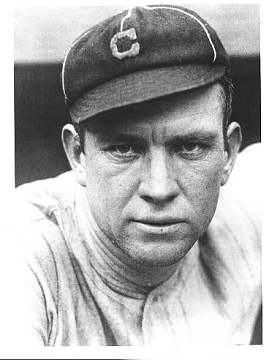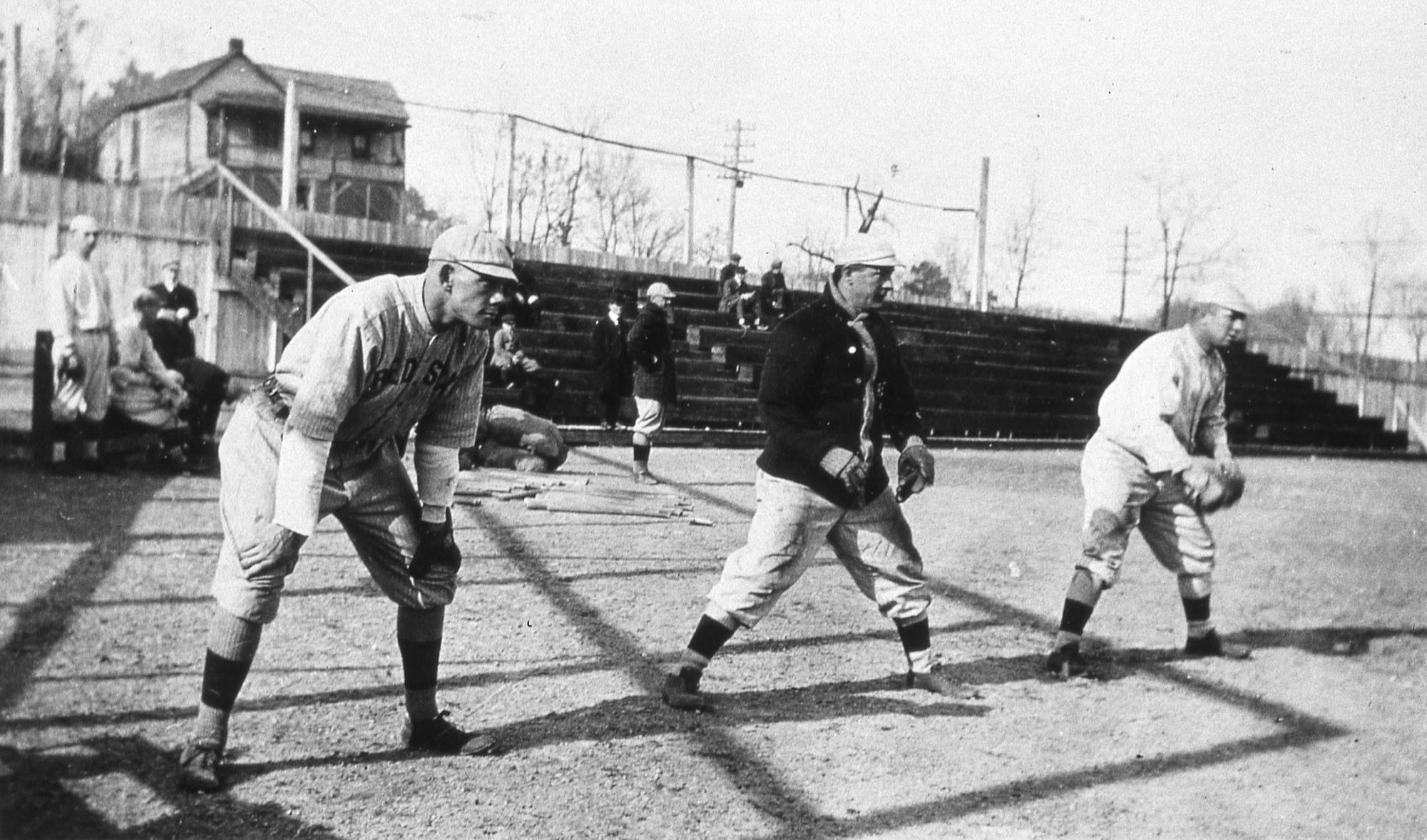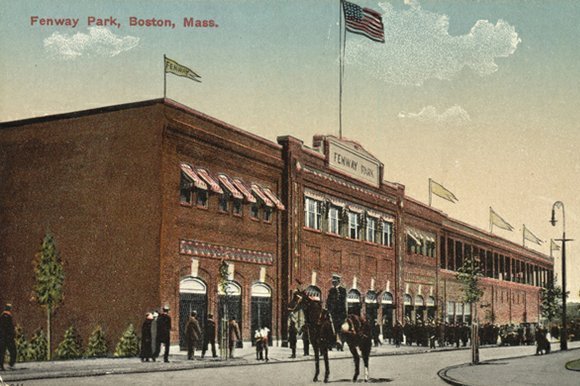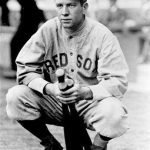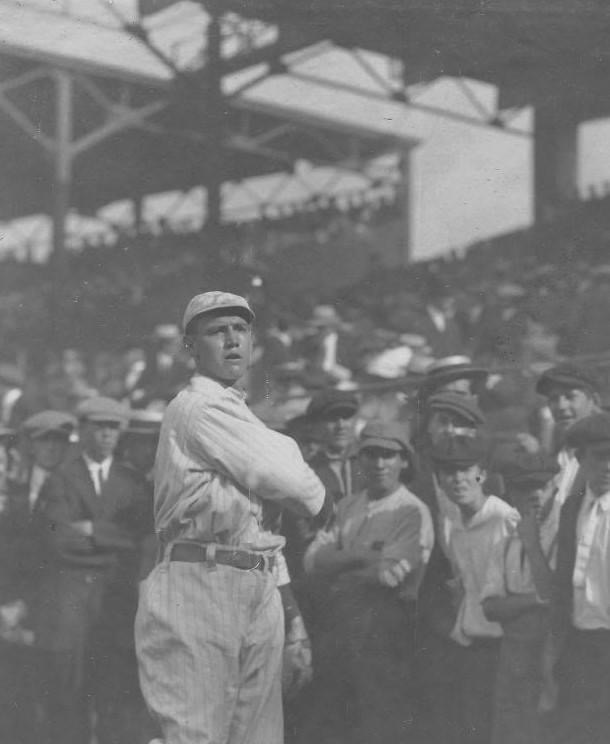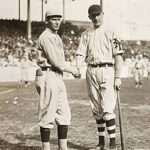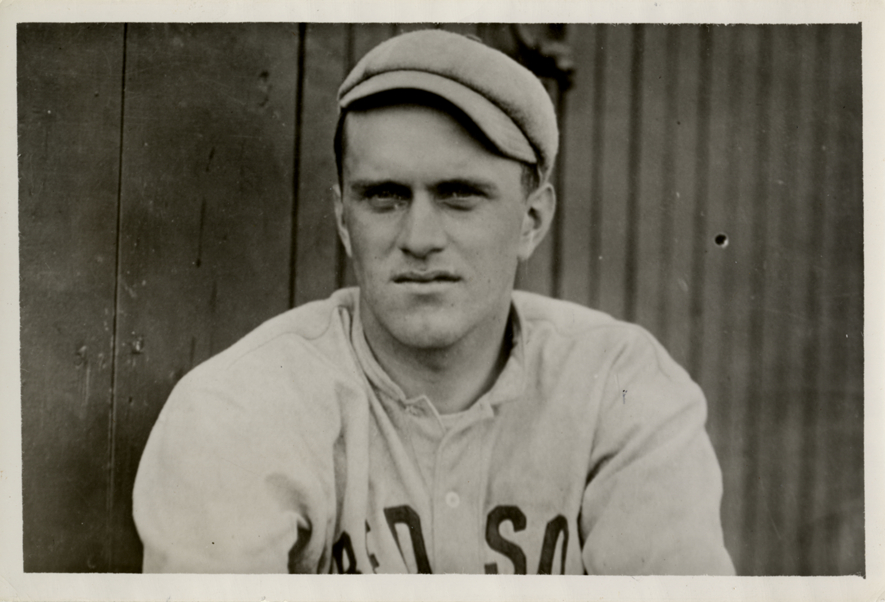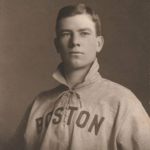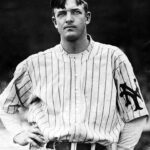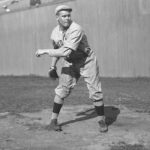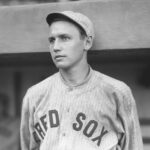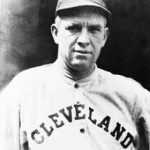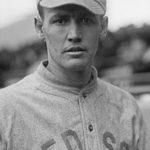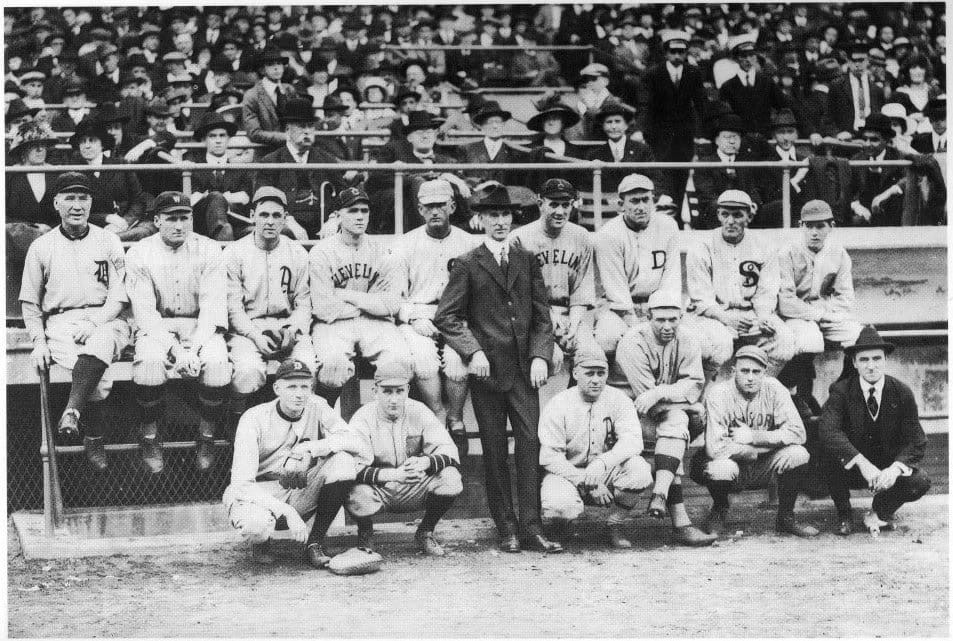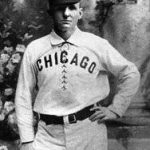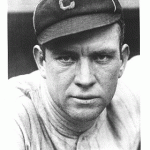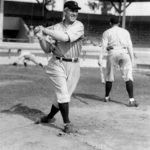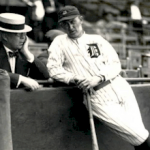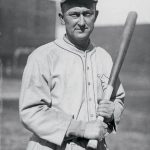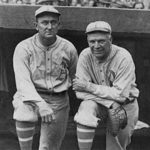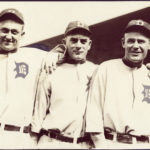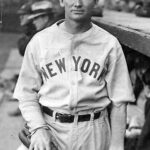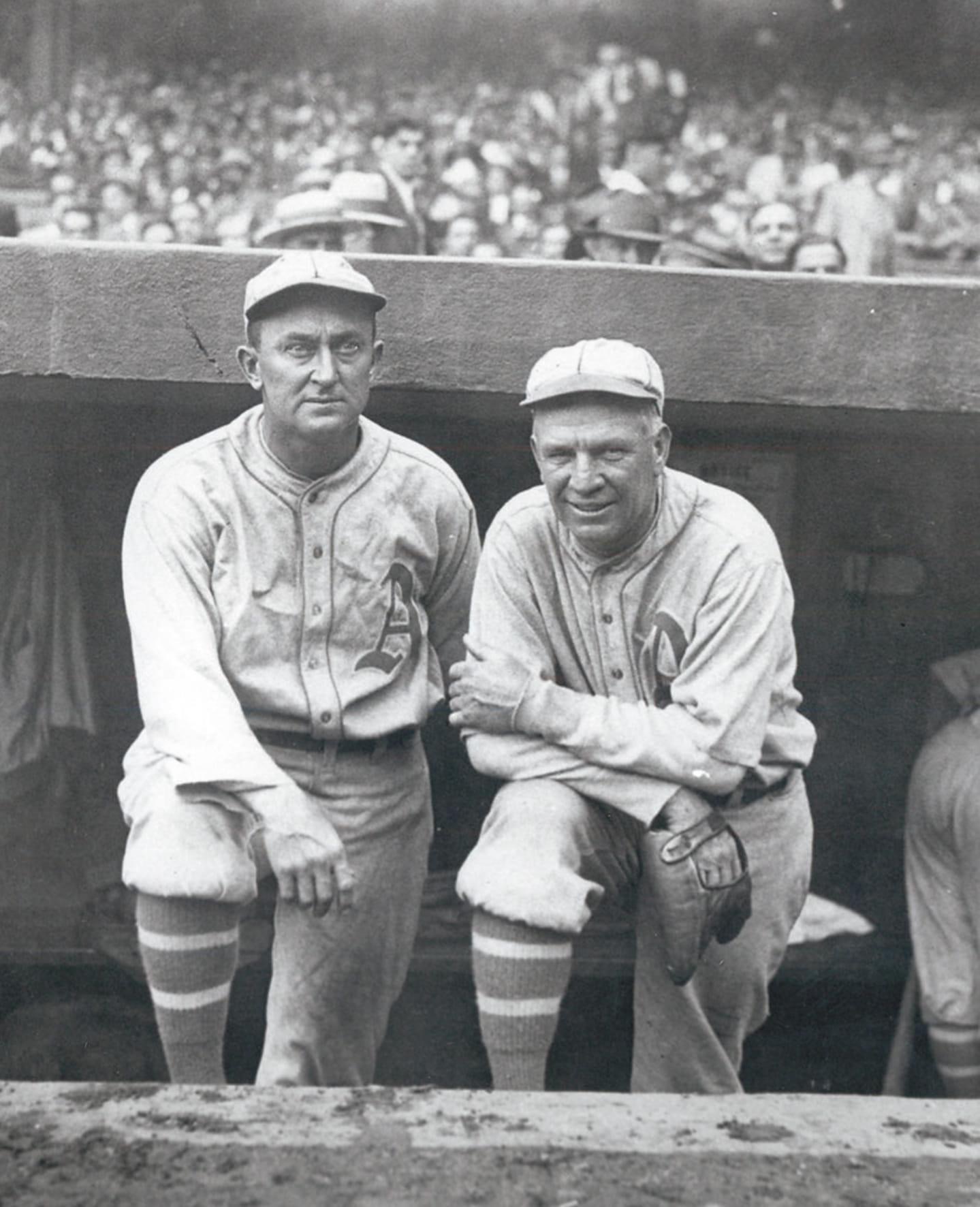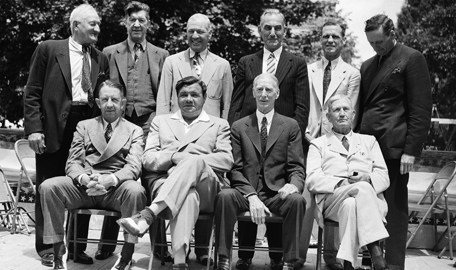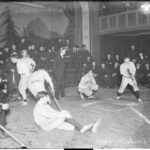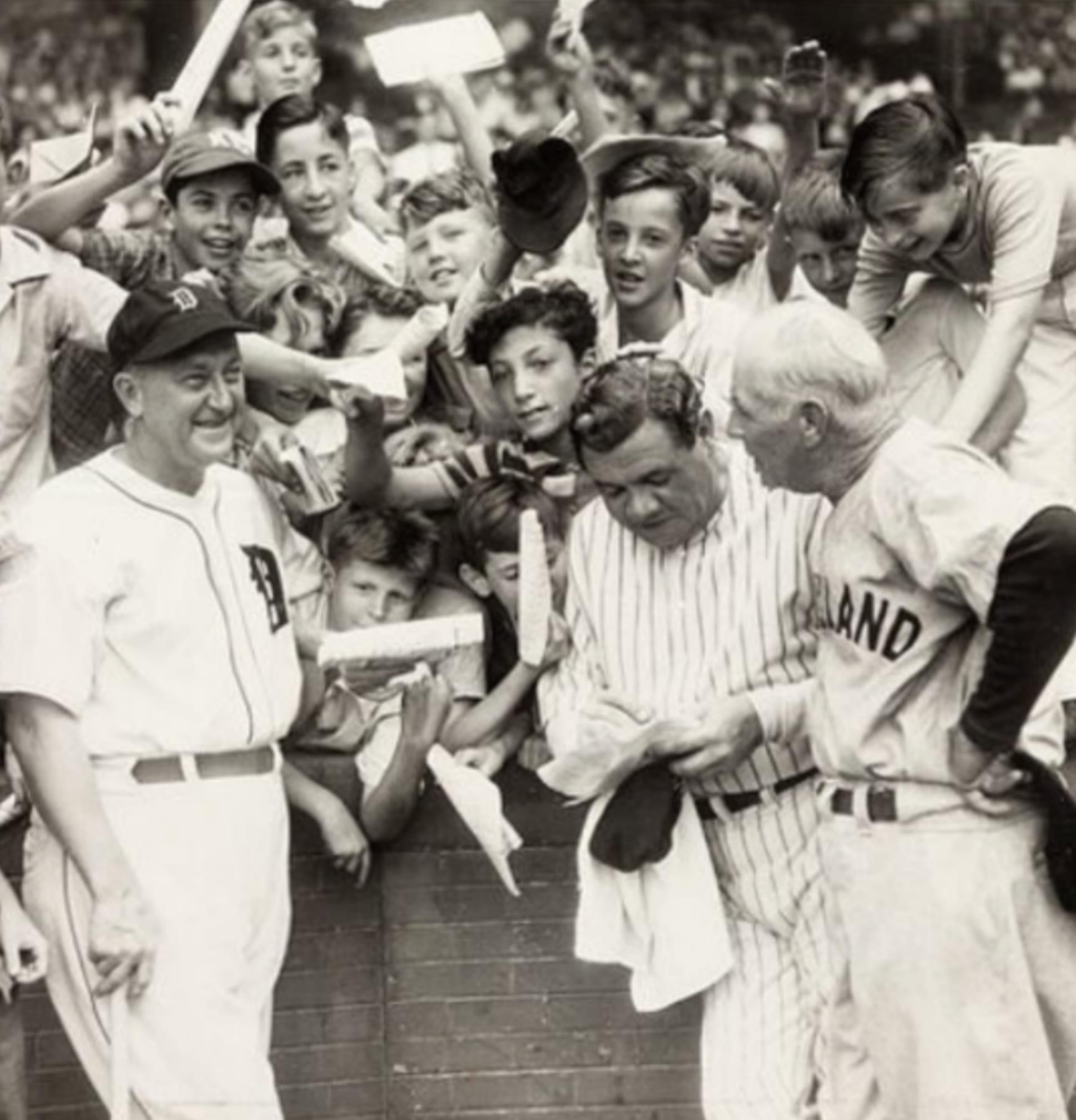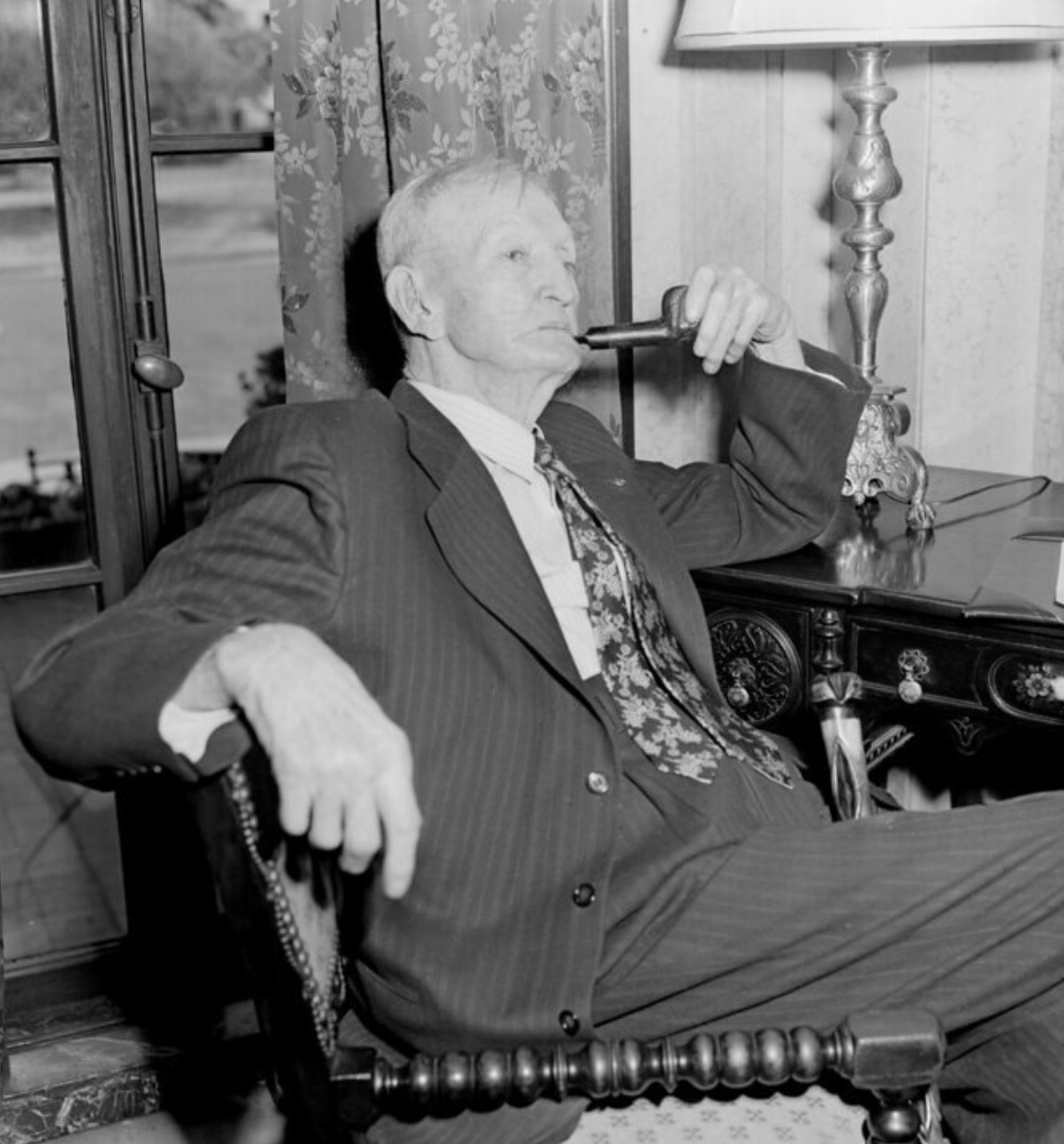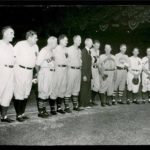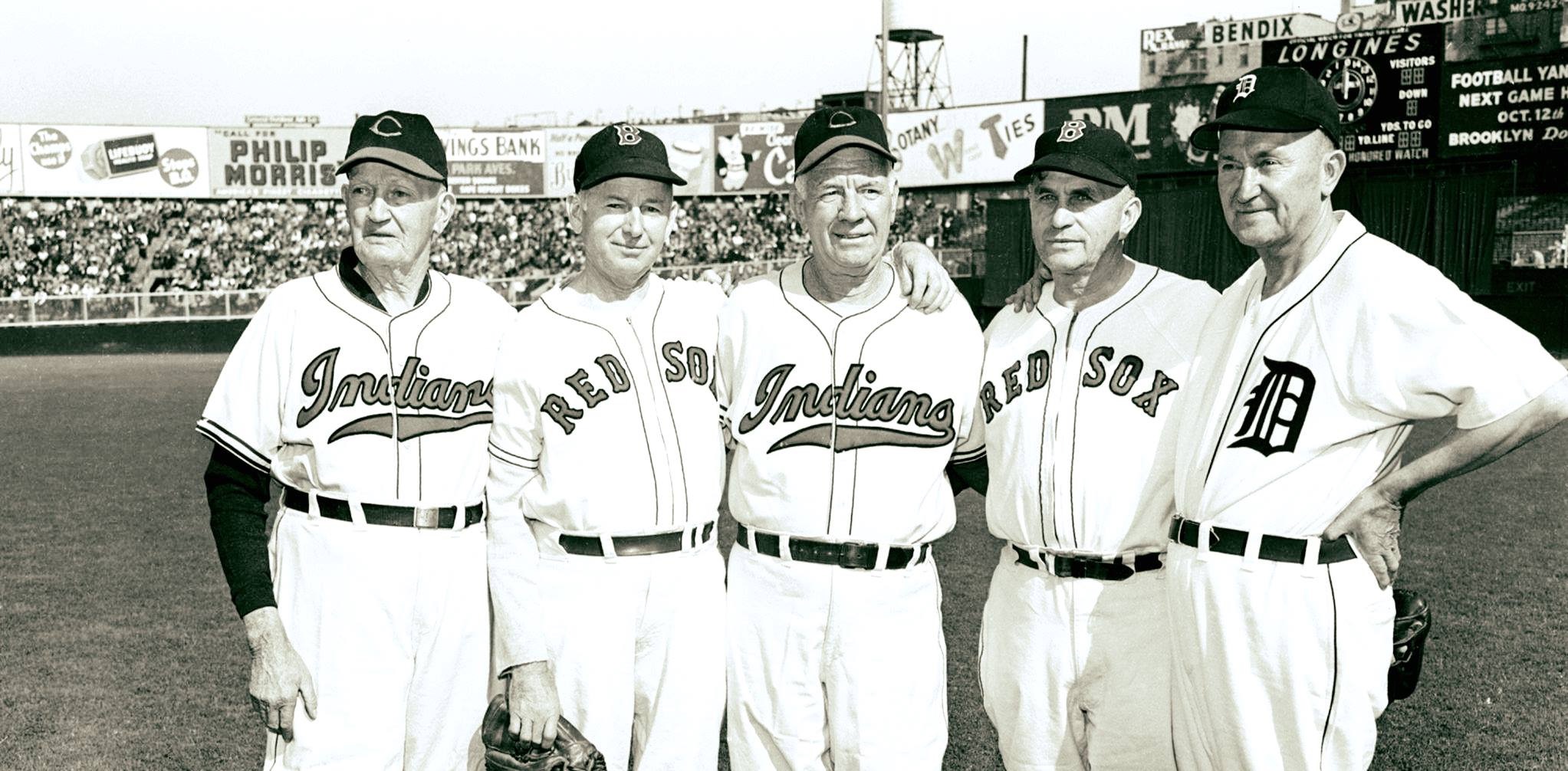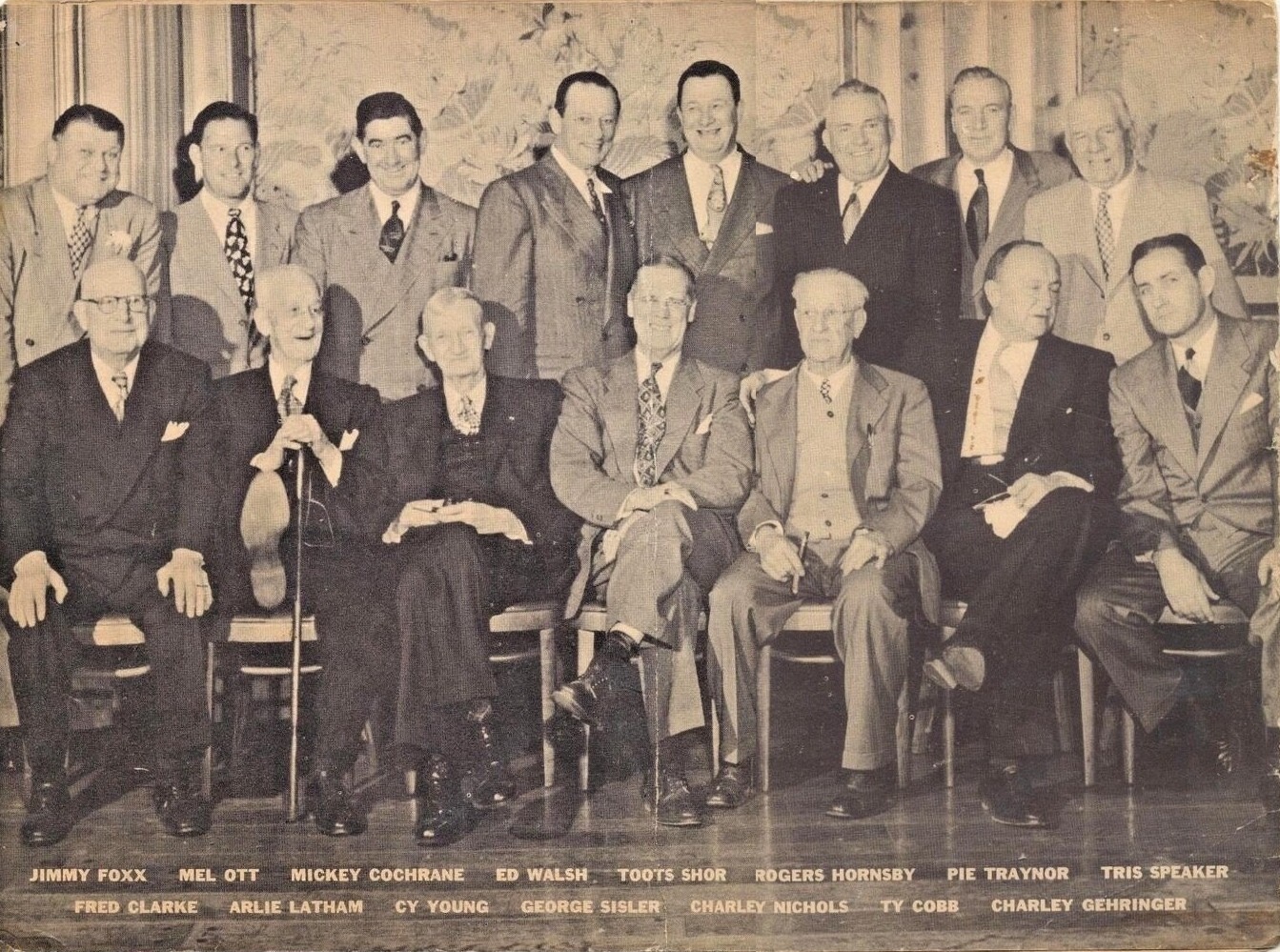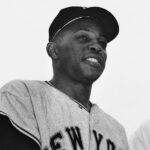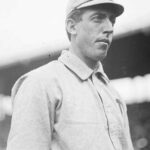Tris Speaker Stats & Facts
Tris Speaker Essentials
Position: Centerfielder
Bats: Left • Throws: Left
5-11, 193lb (180cm, 87kg)
Born: April 4, 1888 in Hubbard, TX
Died: December 8, 1958 in Lake Whitney, TX
Buried: Fairview Cemetery, Hubbard, TX
High School: Hubbard HS (Hubbard, TX)
School: Texas Wesleyan University (Fort Worth, TX)
Debut: September 12, 1907
vs. PHA 2 AB, 0 H, 0 HR, 0 RBI, 0 SB
Last Game: August 30, 1928
vs. BOS 1 AB, 0 H, 0 HR, 0 RBI, 0 SB
Hall of Fame: Inducted as Player in 1937. (Voted by BBWAA on 165/201 ballots)
Induction ceremony in Cooperstown held in 1939.
View Tris Speaker’s Page at the Baseball Hall of Fame (plaque, photos, videos).
Full Name: Tristram E. Speaker
Nicknames: The Grey Eagle
View Player Stats from the B-R Bullpen
View Player Bio from the SABR BioProject
Relatives: Uncle of Tex Jeanes
Nine Players Who Debuted in 1907
Tris Speaker
Ed Konetchy
Clyde Milan
Larry Doyle
Dode Paskert
Fred Merkle
Heinie Zimmerman
Walter Johnson
Bill McKechnie
The Tris Speaker Teammate Team
C: Mickey Cochrane
1B: Jimmie Foxx
2B: Eddie Collins
3B: Larry Gardner
SS: Ray Chapman
LF: Duffy Lewis
CF: Ty Cobb
RF: Harry Hooper
SP: Smoky Joe Wood
SP: Babe Ruth
SP: Herb Pennock
SP: Stan Coveleski
RP: Lefty Grove
M: Connie Mack
Notable Events and Chronology for Tris Speaker Career
Tris Speaker Biography
One of the greatest centerfielders in baseball history, Tris Speaker is considered by many baseball experts to be the finest defensive outfielder ever to play the game. Over the course of 22 major-league seasons, Speaker established numerous fielding marks not likely to be broken. In addition to holding the American League record for most career outfield putouts (6,706), he owns the major-league marks for most career outfield assists (449) and double plays (139). More than just a great fielder, Speaker also excelled both at the plate and on the basepaths, rivaling Ty Cobb as the finest all-around player in the game throughout the second decade of the 20th century. During that 10-year period, Speaker batted well over .300 all but once, topping the .340-mark on five separate occasions. His league-leading .386 batting average in 1916 broke Cobb’s nine-year stranglehold on the A.L. batting title. Speaker also finished in double-digits in triples in nine of those years, collected more than 40 doubles four times, scored more than 100 runs four times, and stole more than 30 bases six times. His 792 career doubles remain the all-time major-league record.
Born in Hubbard, Texas on April 4, 1888, Tristram E. Speaker suffered numerous setbacks as a youth that would have derailed the career of a less determined man. After fracturing his right arm in a fall from a horse, the righthanded Speaker had to learn to throw lefthanded, which he continued to do throughout his baseball career. A few years later, while playing his only year of college ball for Fort Worth Polytechnic Institute, the 17-year-old Speaker severely injured his left arm in a football accident. Surgeons advised amputation, but the resolute Speaker refused, subsequently making a full recovery that enabled him to pursue his dream of playing major league baseball.
Speaker got his start in professional ball one year later, in 1906, playing centerfield for the Cleburne Railroaders of the Texas League. After batting .318 for the Railroaders, Speaker was sold to the Boston Red Sox for $800. He made his major league debut for Boston late in 1907, appearing in only seven games and hitting safely in just three of his 19 at-bats, for an extremely unimpressive .158 batting average. Speaker’s poor performance prompted the Red Sox to trade him to the Little Rock Travelers of the Southern League in exchange for the use of their facilities for spring training the following year. However, Boston reacquired the 20-year-old outfielder after he batted .350 for the Travelers in 1908. Speaker finished the season with the Red Sox, hitting just .224 in the 31 games in which he appeared.
Speaker broke into Boston’s starting lineup the following year, batting .309, driving in 77 runs, and accumulating 13 triples – the first of seven consecutive times he finished in double-digits in three-baggers. Speaker also played a brilliant centerfield, leading all American League outfielders with 35 assists and 12 double plays. Duffy Lewis and Harry Hooper joined Speaker in Boston’s starting outfield in 1910, and the threesome went on to form arguably the finest outfield trio in the major leagues during the Deadball Era. Lewis did an outstanding job of playing Fenway’s short left field wall, while Hooper excelled at covering the ballpark’s vast expanse in right. But Speaker exceeded both his outfield mates, serving as the unit’s unquestioned leader and playing his position in a bold and brazen manner unmatched by any other outfielder.
Speaker’s exceptional speed and uncanny ability to track fly balls enabled him to play an extraordinarily shallow center field. He typically positioned himself a mere 40 or 50 feet behind second base, allowing him to frequently convert line drive singles into outs, throw out runners attempting to advance one base, and occasionally even serve as the middle man on double plays. Speaker later gave much of the credit for his outstanding ability to judge fly balls to Cy Young, a member of Boston’s pitching staff his first few years with the team. Speaker said, “When I was a rookie, Cy Young used to hit me flies to sharpen my abilities to judge in advance the direction and distance of an outfield-hit ball.”
And, as for his ability to serve as the captain of Boston’s outfield, Duffy Lewis stated, “Speaker was the king of the outfield…It was always ‘Take it,’ or ‘I got it.’ In all the years we never bumped each other.”
As Speaker continued to establish himself as baseball’s greatest defensive outfielder, he also developed into one of the game’s premier hitters. Holding the bat relatively low in order to protect the plate, Speaker didn’t hit a lot of home runs. But he compiled huge sums of doubles and triples, and he rarely struck out, never fanning more than 25 times in any single season. The Grey Eagle, as he was known, followed up his solid 1909 performance with batting averages of .340 and .334 the next two years. Speaker then reached the summit of his sport in 1912 when he earned league MVP honors by topping the junior circuit with 10 home runs, 53 doubles, and a .464 on-base percentage, while also placing among the leaders with a .383 batting average, 90 runs batted in, 136 runs scored, 222 hits, and 52 stolen bases. The Red Sox captured the American League pennant and subsequently defeated the New York Giants in the World Series, with Speaker batting .300 during the Fall Classic.
Speaker also performed quite well in each of the next two seasons, posting batting averages of .363 and .338, compiling a career high 22 triples in 1913, and leading the league with 46 doubles and 193 hits the following year, while helping Boston to another world championship. But, when Speaker’s batting average fell to .322 in 1915, Red Sox president J.J. Lannin angered his centerfielder by attempting to reduce his annual salary from $15,000 to $9,000. A war of words ensued, and Speaker was eventually dealt to the Cleveland Indians, who increased his salary to $40,000, making him baseball’s highest paid player.
Speaker showed his appreciation to the Indians his first year with the team by scoring 102 runs and leading the league with a .386 batting average, 211 hits, 41 doubles, a .470 on-base percentage, and a .502 slugging percentage. He continued to play at an extremely high level in his 10 remaining years in Cleveland, compiling batting averages of .352, .388, .362, .378, .380, .344, and .389 in different seasons, surpassing 100 runs batted in and 200 hits twice each, and topping 100 runs scored on three separate occasions. Speaker became the only player in baseball history to lead his league in doubles four straight years when he topped the circuit in that category from 1920 to 1923, with totals of 50, 52, 48, and 59, respectively. In the last of those years, he also established career highs by hitting 17 home runs and knocking in 130 runs. In addition to excelling both at the plate and in the field for Cleveland, Speaker served as the team’s manager from 1920 to 1926, piloting the Indians to their first world championship in 1920, when he also batted .388, knocked in 107 runs, and scored 137 others.
Speaker joined the Washington Senators at the conclusion of the 1926 campaign after being implicated in a gambling scandal involving himself and Ty Cobb. Former pitcher Dutch Leonard claimed that both player-managers fixed at least one Cleveland-Detroit game several years earlier, forcing both men to “resign” as managers under a cloud of suspicion. After Leonard refused to appear at the January 5, 1927 hearings to discuss his accusations, Commissioner Landis cleared both men of any wrongdoing and reinstated them to their original teams. Both Cleveland and Detroit subsequently informed their stars that they were free agents who could sign with any team of their choosing. Speaker signed with Washington, while Cobb joined the Philadelphia Athletics.
Speaker played one year in Washington, before spending his final season as a part-time player with Cobb on the Athletics. Speaker retired at the end of 1927 with a .345 career batting average, a .428 on-base percentage, 3,514 hits, 1,529 runs batted in, 1,882 runs scored, 222 triples, and an all-time record 792 doubles. Speaker’s .345 batting average is the sixth-best in baseball history. He is also sixth all-time in triples, fifth in hits, and eleventh in runs scored. In addition to leading the American League in batting average, home runs, and slugging percentage one time each, he topped the circuit in hits twice, on-base percentage four times, and doubles a record eight times. He also led all American League outfielders in putouts seven times, double plays six times, and assists three times. Speaker batted over .360 eight times, scored more than 100 runs seven times, accumulated more than 200 hits four times, compiled more than 10 triples on 13 separate occasions, and amassed more than 50 doubles five times.
Despite his greatness as a ballplayer, Speaker was hardly a model citizen. In addition to his alleged involvement in gambling on baseball, he reportedly was also a member of the Ku Klux Klan. However, as noted baseball historian Bill James points out, the Klan toned down its racist overtures somewhat during the 1920s, thereby pulling in to its ranks hundreds of thousands of non-racist men. Furthermore, Speaker worked extensively in the outfield with Larry Doby when the latter became the American League’s first black player in 1947. Doby even mentioned Speaker favorably during his Hall of Fame induction speech.
Following his retirement from baseball, Speaker remained close to the game for several more years. Before serving as an adviser, coach and scout for the Indians from 1947 to his death, he briefly managed the Newark Bears of the International League. He also became a part owner of the Kansas City Blues and served for a time as chairman of Cleveland’s Boxing Commission. Among his more philanthropic pursuits, Speaker helped found the Cleveland Society for Crippled Children and Camp Cheerful. Speaker gained induction into the Baseball Hall of Fame during the second year of voting, in 1937, becoming just the seventh player to be so honored. He died of a heart attack on December 8, 1958, at the age of 70.
More than 50 years after his passing, Tris Speaker is still considered by many people to be the greatest defensive centerfielder in baseball history.
Pitcher Smoky Joe Wood, who roomed with Speaker in Boston, said in The Glory of Their Times, “Speaker played a real shallow center field and had terrific instincts…Nobody else was even in the same league with him.”
Joe Sewell played with Speaker in Cleveland. The Hall of Fame shortstop stated emphatically, “I played with Tris for seven years. I’ve seen Joe DiMaggio and I’ve seen Willie Mays…and all the rest. Tris Speaker is the best center fielder I’ve seen.”
@ET-DC@eyJkeW5hbWljIjp0cnVlLCJjb250ZW50IjoicG9zdF90YWdzIiwic2V0dGluZ3MiOnsiYmVmb3JlIjoiTGVhcm4gTW9yZSBhYm91dCB0aGUgdGVhbXMsIHBsYXllcnMsIGJhbGwgcGFya3MgYW5kIGV2ZW50cyB0aGF0IGhhcHBlbmVkIG9uIHRoaXMgZGF0ZSBpbiBoaXN0b3J5IC0gLSAtIC0gLSAtIC0gIiwiYWZ0ZXIiOiIiLCJsaW5rX3RvX3Rlcm1fcGFnZSI6Im9uIiwic2VwYXJhdG9yIjoiIHwgIiwiY2F0ZWdvcnlfdHlwZSI6InBvc3RfdGFnIn19@
Factoids, Quotes, Milestones and Odd Facts
Played For
Boston Red Sox (1907-1915)
Cleveland Indians (1916-1926)
Washington Senators (1927)
Philadelphia Athletics (1928)
Managed
Cleveland Indians (1919-1926)
Similar: Ty Cobb and Paul Waner
Linked: Ty Cobb, who was Speaker’s teammate on the A’s in their final season. The two men were fairly close friends their entire lives.
Best Season, 1912
In 1912 Speaker played in every one of the Red Sox’ 153 games, leading the American League in doubles with 53, and home runs with 10. He set a career high with 222 hits, 136 runs, 580 at-bats, and 52 steals. He was at the top of his game. He batted .383, a mark he would surpass three times in his career, but his .567 slugging percentage was the highest of his dead ball days. His total average, a measure of all-around offensive contribution, was a stellar 1.310 – the highest mark of his career. Speaker set a major league record when he had three batting streaks of 20 or more games during the season. In center field he helped the Red Sox pitching staff by stabbing line drives and throwing out greedy base runners. The Red Sox won their first pennant, and in the World Series victory, Speaker led his team with a .300 batting average, nine hits and four runs scored.
Awards and Honors
1912 AL MVP
Post-Season Appearances
1912 World Series
1915 World Series
1920 World Series
Description
The likable Speaker was intense on the diamond but well thought of by his teammates and opponents. Interestingly, he was a good friend with Ty Cobb, the most vilified man in baseball. The two shared a love for hunting and were thrown together in the 1926-1927 gambling scandal that threatened to tarnish their image. They were also teammates on the 1928 Philadelphia A’s. One can assume they also loved to talk hitting. Cobb considered Speaker the greatest player that he ever played against. For a time, Speaker shared Cobb’s dislike for Babe Ruth, commenting in 1921 that “Ruth made a grave mistake when he gave up pitching. Working once a week, he might have lasted a long time and become a great star.”
Factoid
Tris Speaker is the only player to have three hitting streaks of 20 games or more in one season (1912).
Where He Played: Center field, for all but eight games he played in the outfield. More than 70 years after his retirement, Speaker still holds the ML career record for most assists (448) and double plays (139) by an outfielder. He also owns the AL record for most career outfield putouts (6,706). To top Speaker’s career ML record total of doubles (792) a player would have to average 40 per season for twenty years!
Minor League Experience
1906: Cleburne (North-Texas League)
1907: Houston (Texas League)
1908: Little Rock (Southern Association)
1929-1930: Newark (Intrnational League)
In the North-Texas League in 1906, Speaker was a pitcher. He struggled to an 0-7 record before he was tried in center field. Reportedly, in one of his last games as a pitcher, trailing by a lopsided score, Speaker’s manager shouted from the bench: “Stay out there, Tris, they haven’t got a single hit off you yet!”
The hits Speaker had surrendered had all been for extra-bases.
Notes
On September 1, 1917 in a game against the Tigers in Cleveland, Speaker was hit with the ball as he tried to steal home in the bottom of the first inning. Batter Joe Evans swung away and lined the ball of Speaker’s face. Detroit manager Hughie Jennings, as a courtesy, allowed Speaker to sit out the second inning while his face was sewn up. Elmer Smith played center field until Tris returned in the third. (Source: Retrosheet)… In 19 seasons as a regular, Tris Speaker’s teams won at a .561 clip (1607-1260), winning three World Championships.
Hitting Streaks
30 games (1912)
30 games (1912)
23 games (1923)
23 games (1923)
22 games (1913)
22 games (1913)
20 games (1912)
20 games (1912)
20 games (1912)
20 games (1912)
Transactions
April 12, 1916: Traded by the Boston Red Sox to the Cleveland Indians for Sam Jones, Fred Thomas, and $55000 cash; After being fired by the Indians following the 1926 season, Speaker signed as a free agent with the Senators. He signed with Connie Mack’s A’s in 1928 as a free agent.
Your Typical 5-8-3 Double Play
As a center fielder, Speaker played so shallow for most hitters that he was like a fifth infielder, swift of foot, chasing down potential singles. Twice in 1918, he executed an unassisted double play at second base, snaring low line drives on the run and then beating base runners to the bag. At least once in his career he was credited as the pivot man in a routine double play! Bill Carrigan, a longtime teammate of Speaker’s on the Red Sox, often times would send a pickoff throw from his catcher’s position to Speaker who had snuck in on second base. In addition, as Indians’ manager he insisted the team practice a play where he from center field would cover the keystone sack on bunt plays, thus freeing up his shortstop to cover third, and his third baseman to charge the bunts.
Becoming Manager of the Tribe
In Eugene Murdock’s Baseball Players and Their Times, George Uhle discusses an incident that occurred in his rookie year with the Cleveland Indians, in 1919:
“… According to (Cleveland writer) Franklin Lewis, (manager Lee) Fohl had come to rely heavily on… Speaker for counsel on changing pitchers during a game. If Speaker thought a change would be made he would signal to Fohl in the dugout and also indicate who the replacement would be. In one game in mid-season when things were not going so well, Speaker signaled for a certain pitcher to be brought in from the bullpen. But Fohl misread Speaker’s signal and brought in Fritz Coumbe instead of the man Speaker had intended. At first Speaker tried to correct the mistake, but then realized it would look like he was reversing the manager, so he let it pass. It so happened that Coumbe lost the game and that night Fohl resigned as manager and Speaker was named to replace him. Speaker felt badly about the incident because he felt he was the cause of Fohl’s departure.”
54 years later, Uhle remembered the incident, but couldn’t say for sure if Speaker was making the changes because he was still quite new to the team at the time. However, he said it reminded him of another Coumbe story:
“I was sitting on the bench with Guy Morton one day when we were playing the Yankees. Coumbe was near by. Babe Ruth came up and got a hit. ‘I know how to pitch to that big monkey,’ Coumbe remarked. Well he was sent to the bullpen to warm up and later got into the game. ‘Now we’ll see,’ said Morton, ‘whether he can pitch to Ruth or not.’ Well, Babe knocked the first pitch out of the park. Guy and I both got a big kick out of that and within a day or two, Coumbe was gone just like Fohl.”
As it turns out, these two events happened in the same game. The Tribe played the Red Sox on July 18, 1919. After Cleveland scored four times in the bottom of the 8th to take a 7-3 lead, Boston countered with a run and Coumbe came in to face Ruth with the bases loaded. The Babe unloaded them with his second homer of the game and the Sox won 8-7. The Sporting News reported that Coumbe cried like a baby and Fohl resigned after the game citing growing criticism from the fans. As the Indians had a history of managers quitting mid-season, TSN correspondent Henry P. Edwards stated that, although the resignation was unexpected, the only real surprise would have been if Speaker was not named manager.
(Thanks to Mike Grahek)
Replaced
The regular center fielder for the Red Sox before Speaker won the job late in 1908, was Denny Sullivan, a small left-handed hitter from Wisconsin. Sullivan hit .245 in 1907 with just 19 extra-base hits in 144 games. In 1908, Sullivan was hitting .239 before Speaker took over in center. Sullivan was sold to the Cleveland Naps in September.
Replaced By
Speaker played sparingly in the second-half of the 1928 season for Connie Mack. Speaker had suffered an injuury, and by the time he healed, the A’s were on the winning track with Mule Haas in center field.
Best Strength as a Player
Defensive range
Largest Weakness as a Player
None
Other Resources & Links

